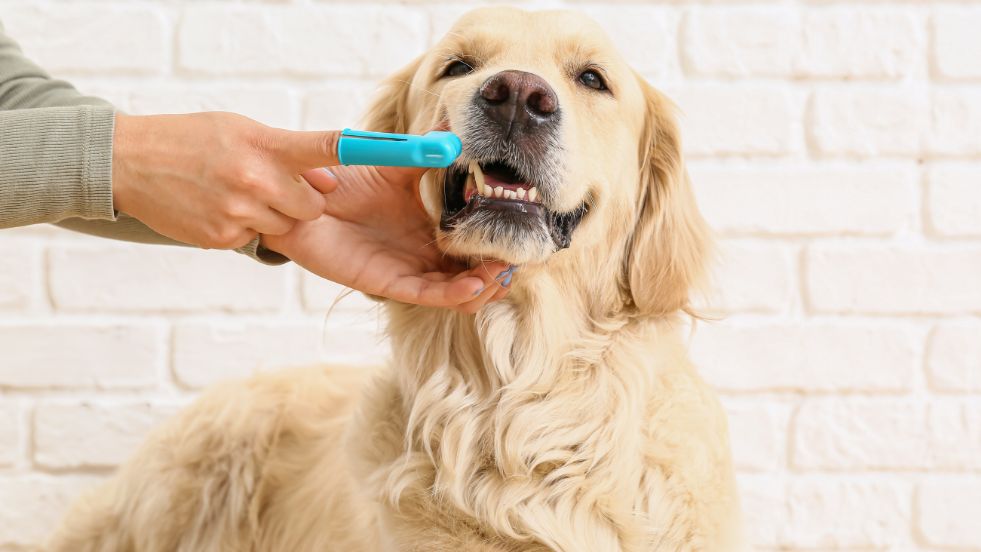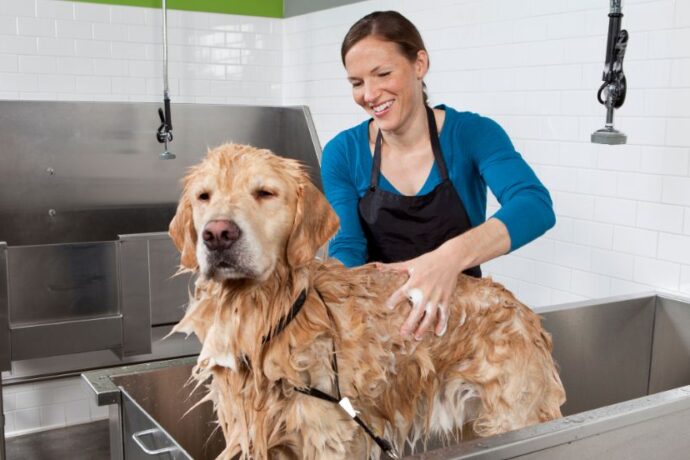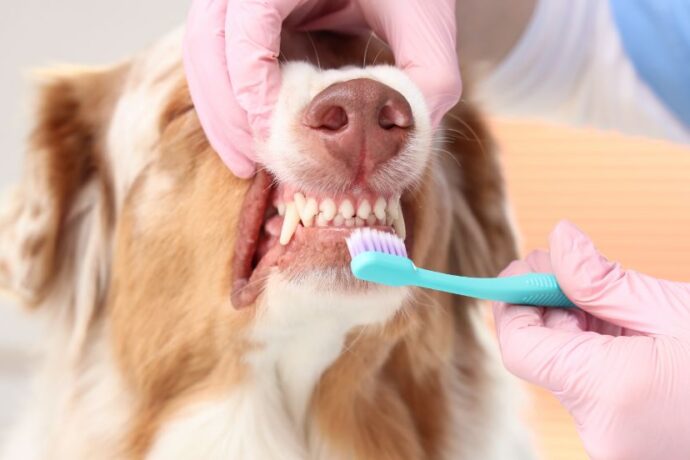A dog’s mouth is more than a tool for chewing toys and food — it’s a window into their overall health. According to the American Veterinary Dental College (AVDC), by age three, nearly 80% of dogs show signs of periodontal disease(1)(2). This condition begins with plaque buildup and can lead to bad breath, gum inflammation, tooth loss, and even systemic issues like heart or kidney disease.
Brushing your dog’s teeth regularly is one of the simplest and most effective ways to prevent these problems. While professional dental cleanings are essential, home brushing — especially with natural, safe products — plays a crucial role in maintaining daily oral hygiene.
Timing Is Everything: When to Start Brushing Your Dog’s Teeth
The best time to start is when your dog is still a puppy, ideally around 8–12 weeks of age. Puppies adapt easily to routines, and early exposure helps them view brushing as normal rather than stressful.
However, it’s never too late to start! Adult dogs can also learn to tolerate — even enjoy — the process with patience and positive reinforcement. Aim to brush your dog’s teeth at least three times a week, though daily brushing provides optimal protection.
Step-by-Step Guide: Training Your Dog to Enjoy Tooth Brushing
If your dog isn’t used to having their mouth handled, jumping straight into brushing can backfire. Gradual desensitization is key.
- Start slow: Begin by gently lifting your dog’s lips for a few seconds each day. Reward them with praise or a small treat.
- Introduce the flavor: Let your dog lick a bit of dog-safe toothpaste or coconut oil from your finger so they associate brushing with a pleasant taste.
- Use your finger first: Before introducing a brush, rub your dog’s gums and teeth gently using your finger or a soft cloth wrapped around it.
- Add the brush: Once your dog feels comfortable, move to a soft-bristled or finger toothbrush. Use circular motions, focusing on the outer surfaces where plaque tends to form.
- Keep it positive: End each session with playtime or a treat. Short, consistent sessions are more effective than forcing long ones.
With time and patience, even the most resistant dogs can learn to enjoy brushing as part of their grooming ritual.
Choosing the Right Toothbrush: What Works Best for Your Pup
- Selecting the correct toothbrush is essential for comfort and effectiveness. Look for:
- Soft bristles to prevent gum irritation.
- Finger brushes for small dogs or beginners.
- Double-ended brushes for large breeds with different mouth sizes.
Avoid using hard or human toothbrushes — they can damage your dog’s gums or enamel. Some pet owners prefer silicone finger brushes for better control and gentler application.
Toothpaste Talk: Why Human Products Aren’t Safe for Dogs
While it might seem convenient to share your own toothpaste, human formulations can be toxic to dogs. Ingredients like xylitol, fluoride, and sodium lauryl sulfate can cause vomiting, low blood sugar, and liver damage.
Instead, opt for dog-safe toothpaste made from natural ingredients such as:
- Coconut oil (antibacterial and plaque-fighting)
- Aloe vera gel (soothes gums)
- Baking soda (gentle cleaning, if used sparingly)
- Parsley or mint extracts (freshens breath)
You can even make your own natural toothpaste at home by mixing coconut oil with a pinch of baking soda and a drop of peppermint oil (ensure it’s pet-safe and diluted).
Natural Alternatives: Gentle, Chemical-Free Ways to Clean Your Dog’s Teeth
If your dog resists traditional brushing, don’t worry — several natural, chemical-free alternatives can help maintain oral hygiene while keeping your dog happy and comfortable. These methods not only help reduce plaque and tartar but also support overall dental health without harsh chemicals.
1. Raw Bones and Natural Chews
Raw meaty bones are one of the most effective natural ways to keep a dog’s teeth clean. Chewing helps mechanically remove plaque and tartar buildup while also exercising the jaw and promoting strong teeth. Important tips:
- Choose the right size: The bone should be larger than your dog’s mouth to prevent choking. Avoid small bones or cooked bones, which can splinter and cause injury.
- Supervise chewing: Always monitor your dog during bone chewing to ensure they don’t swallow large pieces.
- Variety: Long, meaty bones for larger dogs and knuckle or marrow bones for smaller breeds work well.
Natural dental chews are also useful alternatives, especially for dogs who might not tolerate raw bones. Look for vet-approved, all-natural chews without artificial additives, preservatives, or sugar. Chews that have ridges and grooves help scrub teeth naturally while keeping your dog engaged.
2. Coconut Oil Rub
Coconut oil is a versatile, natural substance that can improve oral health. Its antibacterial and antifungal properties help reduce harmful bacteria in the mouth while keeping gums healthy.
- How to use: Dip your finger in a small amount of coconut oil and gently massage it onto your dog’s teeth and gums. Start slowly to let your dog get used to the taste and sensation.
- Benefits: Along with cleaning, coconut oil can help freshen breath naturally and soothe minor gum irritation. Some dogs even enjoy licking a thin layer of coconut oil from a spoon as a treat before brushing.
3. Crunchy Fruits and Vegetables
Certain raw fruits and vegetables can act as natural toothbrushes due to their firm, fibrous texture.
- Carrots: Offer raw, large carrot sticks for dogs who enjoy chewing. Their crunch helps remove soft plaque while providing a low-calorie snack.
- Apples: Sliced apples are another crunchy option, but always remove seeds and cores before offering to your dog. The natural fibers help scrub teeth gently.
- Cucumber or celery: These vegetables are hydrating and crunchy, providing similar plaque-scraping benefits.
These natural snacks not only clean teeth but also provide nutritional benefits like vitamins, fiber, and antioxidants.
4. Herbal Additives
Certain herbs can naturally improve oral hygiene and freshen breath. Parsley, for example, is rich in chlorophyll, which helps neutralize odors. Mint leaves also work well in small quantities. You can add finely chopped herbs to your dog’s meals or use them as a gentle garnish on treats.
5. Water Additives and Enzyme Sprays
There are natural, vet-approved water additives and sprays that help reduce bacterial buildup in the mouth. These products often contain enzymes, probiotics, or herbal extracts designed to:
- Reduce plaque formation
- Freshen breath naturally
- Support overall oral health
- How to use: Add the recommended amount to your dog’s drinking water or spray directly into the mouth a few times per week. These products are especially useful for dogs who are resistant to brushing.
6. Chew Toys Designed for Oral Health
Some chew toys are specifically designed to promote dental hygiene. Look for:
- Textured surfaces that scrub teeth during play
- Durable materials are safe for chewing
- Made from natural rubber or nylon with no toxic additives
When combined with regular brushing or coconut oil rubbing, these toys can significantly reduce tartar buildup over time.
Consistency Is Key
While these natural alternatives are effective, they work best when used consistently and in combination with occasional brushing. Think of them as supportive tools that enhance overall oral care rather than replacements for a well-established routine.
Veterinary studies have shown that dogs who receive a combination of brushing, natural chews, and dietary supplements maintain healthier teeth and gums, experience less tartar buildup, and even have fresher breath compared to dogs who rely solely on chews or diet.
The Science Behind Dog Dental Health: What Studies Reveal
Research supports the importance of at-home oral care for dogs. A study published in the Journal of Veterinary Dentistry found that daily tooth brushing significantly reduces plaque and gingivitis in dogs compared to using dental treats alone (3).
Another study from Applied Animal Behaviour Science revealed that dogs who were gradually trained and positively reinforced for oral care exhibited reduced stress and higher tolerance during dental cleaning routines (4).
This scientific evidence reinforces what experienced veterinarians and behaviorists already know — consistent, gentle brushing paired with natural care methods leads to measurable improvements in dental and overall health.
Frequently Asked Questions
1. Can I skip brushing if I give my dog dental chews?
A. Dental chews help reduce plaque, but they don’t replace brushing. Think of them as a supplement — they work best when combined with regular tooth cleaning.
2. How often should I have my dog’s teeth professionally cleaned?
A. Most veterinarians recommend a professional dental cleaning once a year, though smaller breeds prone to tartar buildup may need it more often.
3. What are the signs that my dog’s teeth need attention?
A. Persistent bad breath, red or bleeding gums, yellow tartar, pawing at the mouth, or difficulty eating are signs of dental issues. If you notice these, schedule a vet visit immediately.
Final Thoughts:
Caring for your dog’s teeth doesn’t have to involve harsh chemicals or stressful vet visits every few months. With a little patience, the right tools, and natural alternatives, you can keep your furry friend’s mouth fresh and healthy.
Remember, consistency is the secret — a few minutes of gentle brushing every day can prevent years of discomfort and disease. Your dog depends on you for their well-being, and every brushstroke is an act of love that adds to their happiness and longevity
References:
1. Revisiting Periodontal Disease in Dogs
2. Periodontal disease
3. Effects of novel dental chews on oral health outcomes and halitosis in adult dogs
4. Improved Oral Health and Adaptation to Treatment in Dogs











